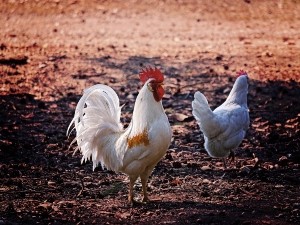
With any living thing, growth happens over time. Chickens grow overtime as well. They grow into their features. So, when do chickens get feathers?
Chickens get their feathers at different times, some chicks will gain feathers within 6 weeks of being born and other breeds will gain feathers at 12 weeks. After moulting, in late summer and fall, they will gain a new set of feathers in time for winter.
Growth is inevitable in chickens. The most visible marker of growth is usually an increase in size, deeper colours, and other visible features. In chickens, growth can be measured through different changes that happen as they age.
Some chickens will require more special feed as they reach certain stages, others begin to exhibit certain behaviours. But the simplest way to measure growth in chickens is by looking at their feathers.
Table of Contents
When do chickens get feathers?
The ageing process in different species happens differently. Chickens will have fully developed feathers at 6 weeks. In some breeds, it might take up to 12 weeks before their feathers are fully developed.
If you own a flock of chickens, you need to pay close attention to this physical change marker as it will tell you a lot about your chicken’s age. For example, below are a few distinctions you can make just by looking at the feathers
Cockerels (male chickens under 1 year old) usually grow pointed feathers around their necks. Roosters (male chicken over one year old) have longer feathers around their mid-torso. Pullets have shorter feathers around their mid-torso.
By nature, chickens and many other animals go through a process called moulting, this means they shed their feathers after a period of time and grow new ones. They will grow new feathers during this time.
How do chicks stay warm in the wild?
Feathers serve as an insulation cover for chickens, enabling them to trap much-needed warmth inside their bodies. We, humans, have winter clothing that helps us stay warm, feathers perform this function in chickens. Feathers also provide shade for chickens during hot summers.
The feathers cover the chicken’s body parts. When they get cold, they may flap their wings to allow air to enter the feathers. Their feathers then trap the air and the warmth generated by their bodies warm the air. They use this technique to maintain a warm temperature so they don’t get cold.
How long do you keep a heat lamp on chickens?
Chickens do not need a heat lamp but chicks do. Chicks can’t stay warm on their own. You can help them by placing a heat lamp in their brooder until they reach 6 weeks. As a general rule, the ideal temperature to start with is around 95°F.
Experts recommend that you reduce this by 5° every week until week 6. Once your teenage chickens have grown their feathers, they no longer need a heat lamp as they can now keep themselves warm.
White bulbs should be avoided as they prevent chicks from sleeping, they may also cause them to stop pecking. Instead of white bulbs, use infra-red bulbs, they are less intrusive and better for the young chicks.
How cold is too cold for chickens?
Chickens are tough creatures, they can easily regulate their body temperature. They love going out in the cold and can handle temperatures below freezing but they can get overwhelmed.
You will know that it’s too cold for chickens when they show the signs of being too cold. This can include standing on one leg, keeping the other leg close to their bodies to keep it warm. They can also sometimes puff their feathers to trap more air, or huddle together in groups.
When you notice these signs, take action by getting them out of the cold and into their coops. Preparing their coops for winter is as simple as providing more floor bedding to provide more insulation, and getting them a heat lamp to keep them warm.
Can chickens freeze to death?
Yes, chickens can freeze to death but this will only happen if you are completely negligent. There are signs to look out for. Once you are proactive, you will never have dead chickens in your flock.
What time of year do chickens usually molt?
Moulting can happen at any time of the year but it generally happens in late summer or fall when the days get shorter. The chicks moult to have a fresh set of feathers to protect them during winter.
You will notice that your chickens will stop laying eggs and this will be accompanied by a loss of feathers. When you notice this reduction in eggs or loss of feathers, this is the best time to increase protein in their diet. This will help their bodies regrow their feathers faster. Once their regrowth is complete, gradually transition back to layer feed so they can get back to laying eggs.
If you’re interested in chickens you may also be interested in these articles: why do chickens dig holes, do chickens yawn, why do chickens eat rocks, how to get chickens back in the coop, how to get chickens used to a new coop, click the links to read more.

